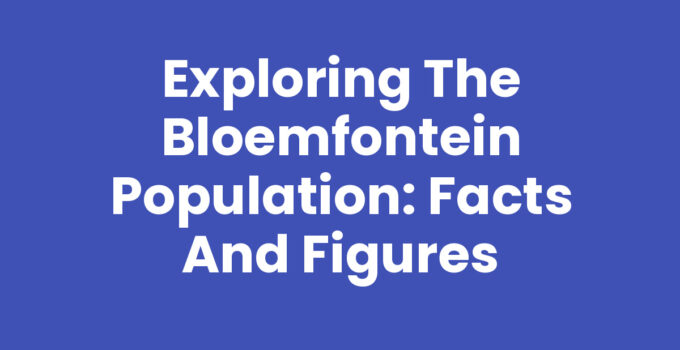Bloemfontein, known as the City of Roses, is one of South Africa’s three capital cities and plays a significant role in the country’s history and economy. Understanding the population of Bloemfontein is not just about numbers; it encompasses a rich tapestry of culture, history, and socio-economic factors that shape the region.
Bloemfontein Population: A Detailed Overview
The Bloemfontein population has seen various shifts and developments over the decades, with significant implications for its urban planning and infrastructure. As of the latest census, the population stands at approximately 500,000 residents. However, numbers alone don’t paint the full picture; demographics, growth rates, and socio-economic circumstances also factor heavily into understanding this vibrant city.
The population density of Bloemfontein is quite distinctive, affected by its geographic layout. Predominantly situated within the Free State province, the city’s demographics indicate a diverse mixture of cultures and ethnicities, influenced largely by the historical migration patterns to the area.
Demographics Breakdown
Examining the demographics of Bloemfontein reveals a population composed primarily of:
- African Black: The majority of Bloemfontein’s residents identify as African Black, a group that showcases a variety of cultures and languages.
- Coloured: This group represents a small but significant percentage of the population, contributing to the city’s cultural richness.
- White: The white population, though smaller in numbers compared to the other groups, plays a vital role in the socio-economic landscape of the city.
The primary languages spoken in Bloemfontein include Afrikaans, Sesotho, and English, reflecting the diversity of its inhabitants. The high rate of bilingualism is common, highlighting a community built on communication and collaboration.
Read Also: Experience the Best Live Music Bloemfontein Has to Offer
Population Growth Trends
Bloemfontein’s population has experienced fluctuating growth rates over the years. Following significant urbanization trends in the late 20th century, the city saw rapid population increases, driven primarily by migration from rural areas and other provinces.
Recent estimates show that from 2011 to 2021, the population grew steadily, albeit at a slower pace compared to the previous decades. This slowdown can be attributed to various factors, including economic conditions and changing employment opportunities, which impact migration patterns. The city’s planning and development strategies now focus on sustainable growth to accommodate an increasing population looking for better living conditions.
Future Outlook
Looking ahead, projections suggest that Bloemfontein will continue to grow, albeit more modestly. Developers and policy-makers are urged to consider infrastructure, housing, and public services to keep pace with the expected demographic changes. Access to education, healthcare, and employment will be critical components influencing the quality of life for the residents.
You Might Also Like: Why is Bloemfontein a Judicial Capital? Discover Its Importance
Why Understanding Bloemfontein’s Population Matters
Understanding the population dynamics of Bloemfontein is crucial for several reasons:
- Urban Planning: City planners and local government use population statistics to project needs in housing, transportation, and public amenities.
- Business Opportunities: Investors and entrepreneurs can identify market opportunities based on demographic trends and consumer behavior.
- Socio-economic Policies: Accurate population data helps in formulating policies that reflect the needs of the community, ensuring that resources are distributed equitably.
As Bloemfontein continues to develop, a keen focus on these aspects will ensure the city’s growth benefits all its residents.
Related Guide: Exploring College Square, Bloemfontein: Your Ultimate Guide
Conclusion
The Bloemfontein population encapsulates a complex and vibrant community reflecting the unique socio-economic landscape of South Africa. From understanding the demographics to following trends in population growth, it is evident that this city is on a path towards a more inclusive and prosperous future.
Related Guide: Explore Westdene, Bloemfontein: Your Ultimate Guide
Frequently Asked Questions
What is the current population of Bloemfontein?
As of the latest census, the population of Bloemfontein is approximately 500,000.
What significant factors influence Bloemfontein's population growth?
Key factors include urbanization, migration from rural areas, and economic conditions in the region.
What are the main languages spoken in Bloemfontein?
The primary languages are Afrikaans, Sesotho, and English, reflecting the city's diverse culture.



